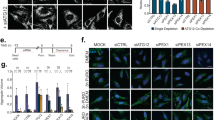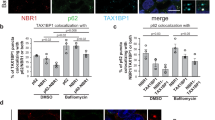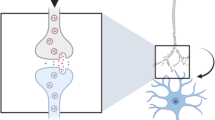Abstract
Abnormal or aggregated proteins have a strong cytotoxic potential and are causative for human disorders such as Alzheimer’s, Parkinson’s, Huntington’s disease and amyotrophic lateral sclerosis1,2,3. If not restored by molecular chaperones, abnormal proteins are typically degraded by proteasomes or eliminated by selective autophagy1,2,3,4,5. The discovery that both pathways are initiated by substrate ubiquitylation but utilize different ubiquitin receptors incited a debate over how pathway choice is achieved2,6,7,8,9,10,11,12,13. Here, we demonstrate in yeast that pathway choice is made after substrate ubiquitylation by competing ubiquitin receptors harbouring either proteasome- or autophagy-related protein 8 (Atg8/LC3)-binding modules. Proteasome pathway receptors bind ubiquitin moieties more efficiently, but autophagy receptors gain the upper hand following substrate aggregation and receptor bundling. Indeed, by using sets of modular artificial receptors harbouring identical ubiquitin-binding modules we found that proteasome/autophagy pathway choice is independent of the ubiquitin-binding properties of the receptors but largely determined by their oligomerization potentials. Our work thus suggests that proteasomal degradation and selective autophagy are two branches of an adaptive protein quality control pathway, which uses substrate ubiquitylation as a shared degradation signal.
This is a preview of subscription content, access via your institution
Access options
Access Nature and 54 other Nature Portfolio journals
Get Nature+, our best-value online-access subscription
$29.99 / 30 days
cancel any time
Subscribe to this journal
Receive 12 print issues and online access
$209.00 per year
only $17.42 per issue
Buy this article
- Purchase on Springer Link
- Instant access to full article PDF
Prices may be subject to local taxes which are calculated during checkout





Similar content being viewed by others
References
Kerscher, O., Felberbaum, R. & Hochstrasser, M. Modification of proteins by ubiquitin and ubiquitin-like proteins. Annu. Rev. Cell Dev. Biol. 22, 159–180 (2006).
Korolchuk, V. I., Menzies, F. M. & Rubinsztein, D. C. Mechanisms of cross-talk between the ubiquitin-proteasome and autophagy-lysosome systems. FEBS Lett. 584, 1393–1398 (2009).
Vilchez, D., Saez, I. & Dillin, A. The role of protein clearance mechanisms in organismal ageing and age-related diseases. Nat. Commun. 5, 5659 (2014).
Nakatogawa, H., Suzuki, K., Kamada, Y. & Ohsumi, Y. Dynamics and diversity in autophagy mechanisms: lessons from yeast. Nat. Rev. Mol. Cell Biol. 10, 458–467 (2009).
Miller, S. B., Mogk, A. & Bukau, B. Spatially organized aggregation of misfolded proteins as cellular stress defense strategy. J. Mol. Biol. 427, 1564–1574 (2015).
Khaminets, A., Behl, C. & Dikic, I. Ubiquitin-dependent and independent signals in selective autophagy. Trends Cell Biol. 26, 6–16 (2016).
Kraft, C., Peter, M. & Hofmann, K. Selective autophagy: ubiquitin-mediated recognition and beyond. Nat. Cell Biol. 12, 836–841 (2010).
Wooten, M. W. et al. Essential role of sequestosome 1/p62 in regulating accumulation of Lys63-ubiquitinated proteins. J. Biol. Chem. 283, 6783–6789 (2008).
Tan, J. M. M. et al. Lysine 63-linked ubiquitination promotes the formation and autophagic clearance of protein inclusions associated with neurodegenerative diseases. Hum. Mol. Genet. 17, 431–439 (2008).
Olzmann, J. A. et al. Parkin-mediated K63-linked polyubiquitination targets misfolded DJ-1 to aggresomes via binding to HDAC6. J. Cell Biol. 178, 1025–1038 (2007).
Lamark, T. & Johansen, T. Aggrephagy: selective disposal of protein aggregates by macroautophagy. Int. J. Cell Biol. 2012, 736905–736921 (2012).
Wurzer, B. et al. Oligomerization of p62 allows for selection of ubiquitinated cargo and isolation membrane during selective autophagy. Elife 4, e08941 (2015).
Cohen-Kaplan, V. et al. The ubiquitin-proteasome system and autophagy: coordinated and independent activities. Int. J. Biochem. Cell Biol. 79, 403–418 (2016).
Komander, D. & Rape, M. The ubiquitin code. Annu. Rev. Biochem. 81, 203–229 (2012).
Rajalingam, K. & Dikic, I. SnapShot: expanding the ubiquitin code. Cell 164, 1074–1074.e1 (2016).
Woelk, T., Sigismund, S., Penengo, L. & Polo, S. The ubiquitination code: a signalling problem. Cell Div. 2, 1 (2007).
Lu, K., Psakhye, I. & Jentsch, S. Autophagic clearance of polyQ proteins mediated by ubiquitin-Atg8 adaptors of the conserved CUET protein family. Cell 158, 549–563 (2014).
Funakoshi, M., Sasaki, T., Nishimoto, T. & Kobayashi, H. Budding yeast Dsk2p is a polyubiquitin-binding protein that can interact with the proteasome. Proc. Natl Acad. Sci. USA 99, 745–750 (2002).
Buchberger, A. From UBA to UBX: new words in the ubiquitin vocabulary. Trends Cell Biol. 12, 216–221 (2002).
Raasi, S., Varadan, R., Fushman, D. & Pickart, C. M. Diverse polyubiquitin interaction properties of ubiquitin-associated domains. Nat. Struct. Mol. Biol. 12, 708–714 (2005).
Seufert, W. & Varshavsky, A. Ubiquitin as a degradation signal. EMBO J. 11, 497–505 (1992).
Brown, J. L. & Zabin, I. β-galactosidase: orientation and the carboxyl-terminal coding site in the gene. Proc. Natl Acad. Sci. USA 58, 1139–1143 (1967).
Seufert, W. & Jentsch, S. In vivo function of the proteasome in the ubiquitin pathway. EMBO J. 11, 3077–3080 (1992).
Seufert, W. & Jentsch, S. Ubiquitin-conjugating enzymes UBC4 and UBC5 mediate selective degradation of short-lived and abnormal proteins. EMBO J. 9, 543–550 (1990).
Fang, N. N. et al. Rsp5/Nedd4 is the main ubiquitin ligase that targets cytosolic misfolded proteins following heat stress. Nat. Cell Biol. 16, 1227–1237 (2014).
Spence, J., Sadis, S., Haas, A. L. & Finley, D. A ubiquitin mutant with specific defects in DNA repair and multiubiquitination. Mol. Cell. Biol. 15, 1265–1273 (1995).
Prag, G., Misra, S., Jones, E. A., Ghirlando, R. & Davies, B. A. Mechanism of ubiquitin recognition by the CUE domain of Vps9p. Cell 113, 609–620 (2003).
Shih, S. C. et al. A ubiquitin-binding motif required for intramolecular monoubiquitylation, the CUE domain. EMBO J. 22, 1273–1281 (2003).
Sumimoto, H., Kamakura, S. & Ito, T. Structure and function of the PB1 domain, a protein interaction module conserved in animals, fungi, amoebas, and plants. Sci. STKE 2007, re6 (2007).
Chuang, K.-H., Liang, F., Higgins, R. & Wang, Y. Ubiquilin/Dsk2 promotes inclusion body formation and vacuole (lysosome)-mediated disposal of mutated Huntingtin. Mol. Biol. Cell 27, 2025–2036 (2016).
Acknowledgements
We thank B. Schulman, B. Pfander and L. Cairo for comments on the manuscript, I. Psakhye for early contributions and discussions, A. Strasser for technical assistance, N. Nagaraj and S. Uebel for mass spectrometry, protein analysis and isothermal titration calorimetry assays, S. Chanarat for Cue5-CUE structure modelling and S. Lindquist (Whitehead Institute for Biomedical Research, USA) and F.-U. Hartl (Max Planck Institute for Biochemistry, Germany) for materials. S.J. is supported by the Max Planck Society, Deutsche Forschungsgemeinschaft, Centre for Integrated Protein Science Munich, Louis-Jeantet Foundation, and a European Research Council (ERC) Advanced Grant.
Author information
Authors and Affiliations
Contributions
K.L. conducted and designed the experiments, F.d.B. and S.J. contributed to the experimental designs, all authors interpreted the data and prepared the paper, and S.J. wrote the manuscript.
Corresponding authors
Ethics declarations
Competing interests
The authors declare no competing financial interests.
Integrated supplementary information
Supplementary Figure 1 Substrate specificity of ubiquitin receptors.
a, Degradation of Ub-βgal-WT in WT and mutant cells. Degradation is strongly impaired in cells deficient in Dsk2, mildly impaired in cells lacking the Dsk2-related protein Rad23, but efficiently degraded in cells lacking the autophagy proteins Cue5 or Atg8. Experiment was performed as in Fig. 1e. Representative image of two independent replicates is shown. b, Cue5 binds the aggregation-prone substrate variant Ub-βgal-X90 stronger than Ub-βgal-WT. Binding does not occur when the ubiquitin-binding CUE is altered (CUEmut). Experiment was performed as in Fig. 3a. Representative image of two independent replicates is shown. c, In contrast to Dsk2-GFP, Cue5-GFP co-localized extensively with TDP-43-mars aggregates (scale bar, 5 μm). Wide-field of cells similar to Fig. 1i. Representative image of two independent replicates is shown. Unprocessed original scans of blots are shown in Supplementary Fig. 5.
Supplementary Figure 2 Ubiquitin modification specificity of Dsk2 and Cue5.
a, ITC analysis of binding properties of the UBA domain of Dsk2 and the CUE domain of Cue5 to mono-ubiquitin and K48- or K63-linked di-ubiquitin. Exceptional injections were excluded. Representative image of two independent replicates is shown. b, Dsk2 with UBA domain replaced by the CUE domain of Cue5 (Dsk2-CUE) binds endogenous ubiquitin conjugates with lower efficiency. Representative image of two independent replicates is shown. c, Dsk2-CUE rescues viability of dsk2 and rad23 double deficient cells at 37 °C. Representative image of two independent replicates is shown. Unprocessed original scans of blots are shown in Supplementary Fig. 5.
Supplementary Figure 3 Cue5 forms oligomers involving its CUE domain.
a, Different regions of Cue5 were purified and subjected to cross-linking as in Fig. 4b. Representative image of two independent replicates is shown. b, Alignment of CUE domain sequences from Cue5, Cue2 and Vps9. The conserved amino acids important for dimerization are boxed. Residues L135-L136 and F109-P110 (in red) are shown in modelled structure of Cue5 CUE domain using UCSF chimera based on Vps9 CUE domain (PDB ID code 1P3Q). Purple: ubiquitin, light blue: CUE (monomer), light green: CUE (monomer). c, Amino acid replacements within the CUE domain of Cue5 impair self-interaction. GST-pull-down assays were performed using His-tagged Cue5 and GST-fusions of WT Cue5 or CUE domain mutant variants of Cue5 (Cue5-F109A, P110A; Cue5-L135A, L136A). A Cue5 variant harbouring amino acid replacements C-terminal of the bona fide CUE domain (Cue5-L174A, L175A) was used as control. Representative image of two independent replicates is shown. d, Amino acid replacements described above impair ubiquitin binding. Experiments were carried out similar as in c with purified proteins and yeast cell lysates. Representative image of two independent replicates is shown. Unprocessed original scans of blots are shown in Supplementary Fig. 5.
Supplementary Figure 4 Functionality of synthetic receptors.
a, Expression levels of synthetic receptors. Yeast cells expressing the synthetic receptors described in Fig. 5a were analysed as in Fig. 3d. Representative image of two independent replicates is shown. b, Oligomerization potential of the artificially constructed autophagy receptors shown in Fig. 5a. Constructs were purified at concentration of 1 mg ml−1 and exposed to formaldehyde-cross-linking (1.85%) for 1 h prior to analysis by SDS polyacrylamide gel electrophoresis. Coomassie-stained gel is shown. Representative image of two independent replicates is shown. c, Degradation of aggregation-prone Ub-βgal-X90 (top panel) mediated by the synthetic oligomeric receptor (2FK-OAIM) is independent of Dsk2 (Δdsk2Δcue5 lanes) but depends on the autophagy pathway (Δatg8Δcue5 lanes). By contrast degradation of soluble Ub-βgal-WT by monomeric receptor (2FK-MUBL−AIM) (bottom panel) is independent of autophagy. Experiment was performed as in Fig. 1e. Representative image of two independent replicates is shown. d, The synthetic oligomeric receptor (2FK-OAIM) is as potent as Cue5 in mediating degradation of aggregation-prone Ub-βgal-X90. In contrast, the dimeric receptor (1FK-DAIM) is not able to support efficient degradation of Ub-βgal-X90. Experiment was performed as in Fig. 1e. Representative image of two independent replicates is shown. e, Differential binding of monomeric and oligomeric synthetic receptors to Ub-βgal-WT and Ub-βgal-X90. GST-pull-down assays were performed as in Fig. 1g. Representative image of two independent replicates is shown. f, Binding of monomeric and oligomeric synthetic receptors to the proteasome is similar and does not affect Dsk2 binding to the proteasome. Co-IP assays with the indicated antibodies were performed as in Fig. 3a. Representative image of two independent replicates is shown. g, The oligomeric receptor (2FK-OUBL) shows no dominant negative effect on degradation of Ub-βgal-WT in the presence of Dsk2. The experiment was performed as in Fig. 1e. Representative image of two independent replicates is shown. h, The oligomeric receptor (2FK-OUBL) shows no negative effect on cell growth. The experiment was also performed as in Supplementary Fig. 2c. Representative image of two independent replicates is shown. i, Co-localization of GFP-tagged oligomeric (2FK-OAIM), but not monomeric (2FK-MAIM) receptors with mars-labelled TDP-43 protein aggregates. Dimeric receptors (1FK-DAIM) show only weak co-localization with aggregates (scale bar, 5 μm). Wide-field of cells similar to Fig. 5d. Representative image of two independent replicates is shown. Unprocessed original scans of blots are shown in Supplementary Fig. 5.
Supplementary information
Supplementary Information
Supplementary Information (PDF 19502 kb)
Supplementary Table 1
Supplementary Information (XLS 25 kb)
Supplementary Table 2
Supplementary Information (XLS 26 kb)
Supplementary Table 3
Supplementary Information (XLS 33 kb)
Rights and permissions
About this article
Cite this article
Lu, K., den Brave, F. & Jentsch, S. Receptor oligomerization guides pathway choice between proteasomal and autophagic degradation . Nat Cell Biol 19, 732–739 (2017). https://doi.org/10.1038/ncb3531
Received:
Accepted:
Published:
Issue Date:
DOI: https://doi.org/10.1038/ncb3531
This article is cited by
-
Imaging strategies for receptor tyrosine kinase dimers in living cells
Analytical and Bioanalytical Chemistry (2023)
-
Carrying Excess Baggage Can Slowdown Life: Protein Clearance Machineries That Go Awry During Aging and the Relevance of Maintaining Them
Molecular Neurobiology (2022)
-
UXT chaperone prevents proteotoxicity by acting as an autophagy adaptor for p62-dependent aggrephagy
Nature Communications (2021)
-
VPS34 K29/K48 branched ubiquitination governed by UBE3C and TRABID regulates autophagy, proteostasis and liver metabolism
Nature Communications (2021)
-
Spatial control of avidity regulates initiation and progression of selective autophagy
Nature Communications (2021)



